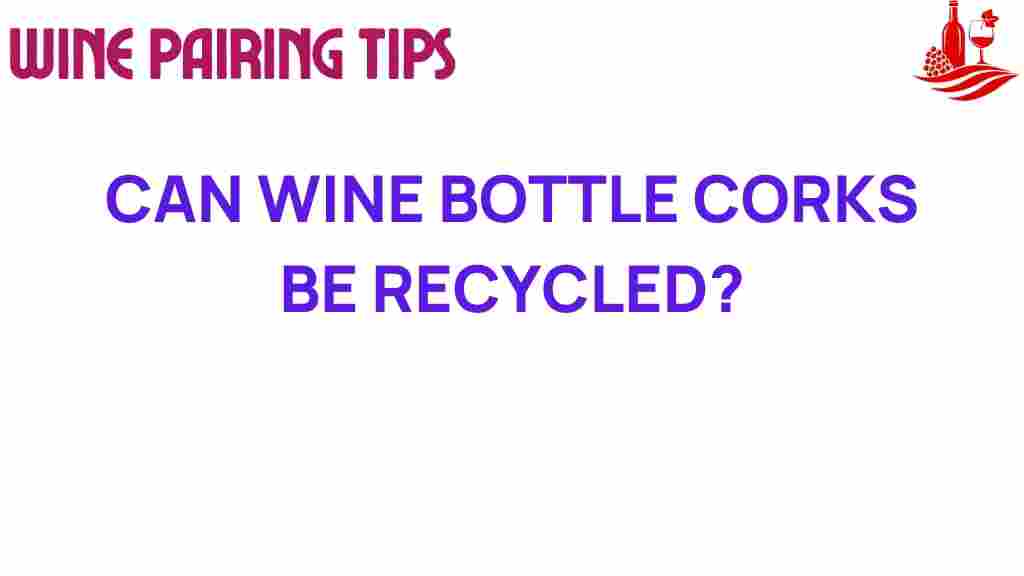The Surprising Truth About Recycling Wine Corks
As the world becomes increasingly aware of sustainability and eco-friendly practices, the spotlight on various materials and their disposal methods has intensified. One such item that often gets overlooked is wine corks. With millions of bottles opened each year, the question arises: what happens to all those wine corks? In this article, we will explore the fascinating journey of wine corks, their impact on the environment, and the recycling options available to help reduce waste in the wine industry.
Understanding Wine Corks
Wine corks are primarily made from the bark of cork oak trees, which are native to the Mediterranean region. These trees are remarkable for their ability to regenerate their bark, making cork a renewable resource. However, the growing trend of sustainability has led to the development of various cork alternatives, raising questions about their environmental impact.
The Importance of Recycling Wine Corks
Recycling wine corks is an essential practice for achieving waste reduction and minimizing the environmental impact associated with wine consumption. Here are some crucial reasons why recycling wine corks is important:
- Waste Reduction: Millions of corks end up in landfills each year, contributing to the growing waste crisis.
- Environmental Impact: Cork oak forests play a critical role in biodiversity and carbon sequestration. Recycling supports the preservation of these ecosystems.
- Supporting the Wine Industry: By recycling corks, you contribute to a circular economy within the wine industry, encouraging sustainable practices among producers.
How to Recycle Wine Corks
Recycling wine corks is easier than you might think. Here’s a step-by-step process to ensure you’re doing your part for the environment:
Step 1: Collect Your Corks
Start by collecting your wine corks. You can set aside a designated container in your kitchen or dining area to make this easier. Remember, both natural corks and synthetic corks can be collected, but they may have different recycling processes.
Step 2: Research Local Recycling Programs
Not all recycling centers accept wine corks, so it’s crucial to research local programs. Many regions have specific drop-off points or community initiatives aimed at recycling corks. You can also check for local wineries or restaurants that may participate in cork recycling initiatives.
Step 3: Use Cork Recycling Programs
There are several organizations dedicated to recycling corks, such as:
- Cork ReHarvest: This program collects corks and turns them into new products, contributing to sustainability.
- ReCork: A North American cork recycling program that partners with various businesses to recycle corks effectively.
To find a program near you, visit their websites for more information on how to send or drop off your corks.
Step 4: Get Creative with Upcycling
If you’re feeling crafty, consider upcycling your wine corks into fun and functional items. Here are some ideas:
- Cork coasters
- Cork bulletin boards
- Cork trivets
- Wine cork keychains
By upcycling, you not only reduce waste but also create unique items that can serve a purpose in your home.
Troubleshooting Common Issues
While recycling corks is generally straightforward, you may encounter some challenges. Here are some troubleshooting tips:
Problem: Local Programs Don’t Accept Corks
If your local recycling program does not accept corks, don’t despair. Consider reaching out to nearby wineries, restaurants, or even schools that may have cork recycling initiatives.
Problem: Difficulty Finding Information
If you’re having trouble finding information about cork recycling in your area, utilize social media platforms or community forums. Often, local groups are passionate about sustainability and can provide leads.
Problem: Confusion Over Cork Alternatives
Many wine producers are now using synthetic corks made from materials like plastic or composite corks. These alternatives may not be recyclable in the same way as natural corks. Always check the materials before recycling and follow guidelines provided by local programs.
Exploring Cork Alternatives
As the wine industry evolves, so do the materials used for sealing wine bottles. Here are some popular cork alternatives and their environmental implications:
- Synthetic Corks: Made from various plastics, these are often non-biodegradable and do not decompose easily.
- Composite Corks: These combine natural cork with recycled materials, but their recyclability can vary.
- Screw Caps: Increasingly popular, screw caps are typically recyclable but can also be made from non-recyclable materials.
When choosing wine, consider looking for brands that prioritize eco-friendly practices, whether through natural corks or sustainable alternatives.
Green Practices in the Wine Industry
The wine industry is increasingly adopting green practices to promote sustainability. Here are some examples:
- Organic Farming: Many wineries are shifting to organic practices, reducing chemical usage and promoting biodiversity.
- Water Conservation: Sustainable vineyards prioritize water conservation techniques to reduce their environmental impact.
- Solar Energy: Some wineries are investing in renewable energy sources, such as solar panels, to power their operations.
By supporting wineries that embrace these practices, consumers can contribute to a more sustainable wine industry.
Conclusion
The surprising truth about recycling wine corks is that it’s a simple yet impactful way to contribute to sustainability and waste reduction. By being mindful of how you dispose of wine corks and supporting eco-friendly practices in the wine industry, you can help reduce the environmental impact of wine consumption. Remember, every cork recycled is a step toward a greener planet.
For more information on recycling and sustainability practices, check out this resource. To learn about local cork recycling programs, visit this page.
This article is in the category Tips and created by Wine Pairing Tips Team
